| |
Ferocious gestures combined with black warrior paint patterned across Sairusi’s torso and face gave me pause: was this the easygoing First Mate who has been shuttling us between ship, islands and coral reefs? Or was this war dance flooding him with ancestral memories, dredging up emotions from Fiji’s cannibal past? |
|
| |
|
|
| |
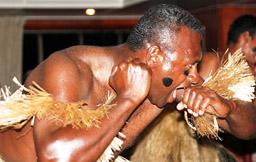 |
|
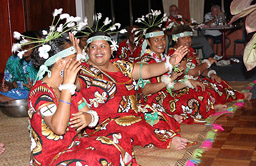 |
|
| |
War Club Dance |
|
Meke Women |
|
| |
|
|
|
|
| |
It is Pacific Island Night aboard the MV Reef Endeavour, and the meke (song and dance) performed by the crew is a reminder of encounters we had enjoyed over the past few days. This being Fiji, it would be far from the last meke performance of this trip.
The islands of Fiji scatter across nearly a half-million square miles. Counting every islet, they number over a thousand although only 322 are deemed large enough to live upon, and of those only 106 are inhabited. |
|
| |
|
|
| |
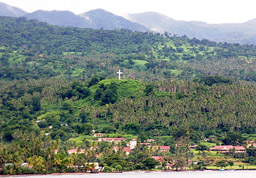 |
|
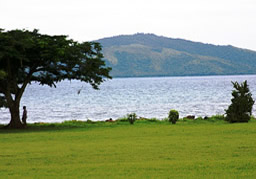 |
|
| |
Small villages such as Wairiki dot the west side of Taveuni |
|
Vanua Levu, second largest island in Fiji, lies across the Somosomo Strait from Wairiki |
|
| |
|
|
| |
Viti Levu is the biggest island, and home to the International Airport in Nadi. About 180 miles northeast lies Taveuni, third largest island at 26 miles long, averaging seven miles wide. Known as the Garden Island, its rich volcanic soil nourishes lush tropical foliage and abundant crops of fruits and vegetables.
Taveuni also has the distinction of having been home to the most savage of all the cannibal tribes in Fiji. That passed into history in the 1870’s leaving today’s inhabitants to live quietly in villages around the island, many working the copra plantations. Taveuni’s highest point, Mount Uluiqualau, rises to 4,040 feet and is bisected by the 180th Meridian, exactly halfway around the world from Greenwich, England. |
|
| |
|
|
| |
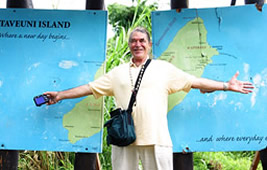 |
|
|
|
| |
Steve Giordano, of HighOnAdventure fame, straddles the International Date Line sign in Waiyevo, his left arm in Yesterday and his right in Today |
|
The unpretentious Taveuni
Country Club |
|
| |
|
|
| |
Waiyevo sits mid-point on the west side of Taveuni, straddling the 180th Meridian. In most parts of the world the International Date Line follows this meridian. But unscrupulous employers took advantage of this non-geographical, non-political divider to make their native workers, who were supposed to have Sundays off, labor seven days a week.
If it was Sunday on the west side of the date line, employers pointed out it was Saturday on the east side and moved their workers to the east. The next day, when Saturday became Sunday on the east side of the date line, employers moved them to the west side of their properties where it was already Monday. In 1879 the entire Date Line was moved east of Fiji and thus resolved this game-playing. A short trek across a football field reveals the colorful sign marking the location of the original troublesome Date Line. |
|
| |
|
|
| |
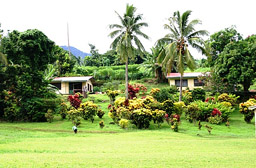 |
|
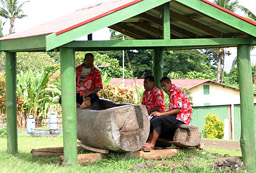 |
|
| |
Luxuriant tropical foliage permeates the village of Wairiki |
|
Wairiki’s huge Lali drum, carved from a single log, calls worshippers to Sunday service |
|
| |
|
|
|
|
| |
.jpg) |
|
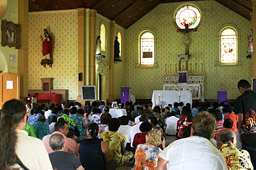 |
|
| |
Wairiki Church (Photo courtesy Dave Robinson www.daverobinson.id.au)
|
|
|
|
| |
|
|
| |
Just a bit more than a mile south of Waiyevo is the picturesque village of Wairiki. Partway up the hillside sits the Catholic church, constructed of stone in 1907. Stained glass windows punctuate the walls and solemn statues look down from high shelves. The congregation files up the grassy path lined with colorful ti plants and fragrant tropical flowers to take seats on woven mats inside the church. A dozen side doors are flung open so soft breezes can waft across the room.
Periodically throughout the service, the church suddenly fills with the most amazing singing I’ve ever heard in a place of worship. No microphones, no choir director, no musical instruments—just unbelievable song emanating from a handful of villagers sitting amongst the parishioners, a rich and powerful sound that resonates through my body. It is as beautiful and tranquil as the village of Wairiki. |
|
| |
|
|
| |
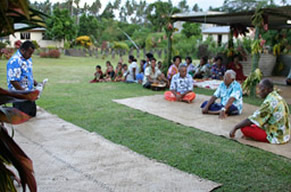 |
|
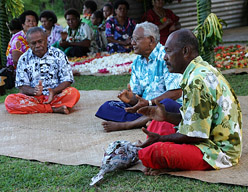 |
|
| |
Presentation of the sevusevu to Paramount Chief Talemo and the Village Elders |
|
The bundle of dried waka is accepted (Chief Talemo in the middle) |
|
| |
|
|
| |
On the northern tip of Taveuni is the village of Naselesele, home of Talemo, Paramount Chief over half the villages on the island. I was fortunate to attend a Naselesele Lovo, preceeded by a formal Sevusevu and followed by an evening of Meke. Let me explain…
In Fijian society, you don’t just wander into a village. You come humbly, bearing a sevusevu or gift of waka, the dried root of the yagona, a type of pepper plant. It is presented to the chief or highest ranking person in the village, and if he accepts your gift, a kava ceremony ensues. |
|
| |
|
|
| |
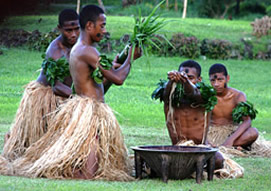 |
|
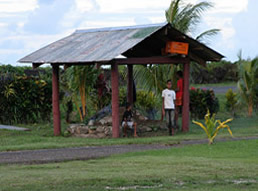 |
|
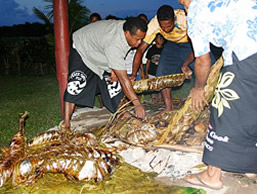 |
|
| |
Preparation of kava is a solemn part of formal acceptance into a Fijian village |
|
Ingredients for the Lovo feast steam |
|
to perfection in the underground oven |
|
| |
Carefully opening the hot taro leaf-wrapped bundles reveals a treasure-trove of native delectables such as this blend of bananas, cassava and sweet potatoes |
|
| |
|
|
| |
Once the kava has been properly “brewed” and imbibed by the high-ranking persons of the village and our group, we are formally welcomed into the village with heartfelt song. Soon comes the unveiling of the lovo, or underground oven, which had spent most of the day steaming succulent packages of meat, fish and vegetables. I circled tables laden with the culinary range of local favorites, taking only a small one- or two-bite portion of each item, but still reached my seat with a plate piled higher than I had planned. (Note to Self: Next time, ONE bite each!) |
|
| |
|
|
| |
|
|
| |
The meke, or singing and dancing, began, and would continue well into the evening. From the smallest child to their great-grandparents, the people of Naselesele presented a tableau of entertainment that captivated us. |
|
| |
Even the youngest villagers learn, and obviously have fun with, their native background |
|
| |
Steve Giordano is persuaded to join the Taralala dance |
|
| |
|
|
| |
With brightly colored clothing and traditional costumes swaying and rustling in the falling dusk, the villagers brought their legends and stories to life. We were treated to War Club dances, the young men reenacting their fierce warrior history. The women shared Seasea dances, flourishing woven fans in graceful patterns and flirtatiousness. With huge smiles and twinkling eyes, they were obviously having as much fun as we were. Finally they began to draw us to our feet, inviting us to join them in the Taralala, a side-by-side two-step shuffle. I couldn’t refuse—I wanted to be part of their celebration, to feel the exuberance they felt as they celebrated their Fijian culture. |
|
| |
|
|
| |
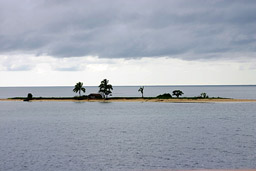 |
|
|
|
| |
Sali Sali Manava Cay is a tiny coral reef (left) with three palm trees, five shrubs, incredible beachcombing, a fisherman’s shack for hiding out the worst of rains, and is surrounded by extraordinary snorkeling and diving. Just offshore from Whispering Tide (right) is a reef brimming with tropical fish and an amazing variety of coral. |
|
| |
|
|
| |
|
Divers and snorkelers flock to Fiji, which Jacques Cousteau called the “Soft Coral Capital of the World.” Over one quarter of the coral reefs in the South Pacific are found here, including almost 400 species of coral. Many coastlines feature fringing reefs, plus 33 barrier reefs including the Great Sea Reef, fourth-largest in the world, off the north coast of Vanua Levu. Fijian waters teem with an abundance of diverse marine life. |
|
|
| |
|
|
|
|
| |
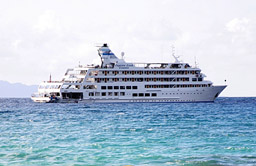 |
|
.jpg) |
|
| |
The MV Reef Endeavour at anchor off Sali Sali Manava Cay |
|
Snorkeling (Courtesy Captain Cook Cruises) |
|
| |
|
|
|
|
| |
One of the best ways to explore these islands and the diving and snorkeling opportunities is with Captain Cook Cruises. Headquartered in Australia, they run a number of options in Fiji including day trips out of Nadi. But to reap the most experiences and have the chance to explore a number of islands and some top notch diving and snorkeling, hop aboard one of their Discovery Cruises. The Discovery Heritage and Discovery Cultural Cruises are 7-night excursions, and the Discovery Yasawa Islands has 3-, 4- or 7-night options. |
|
| |
|
|
| |
Captain Cook Cruises' MV Reef Endeavour’s glass-bottom boat shuttles passengers between the ship and great snorkeling locations |
|
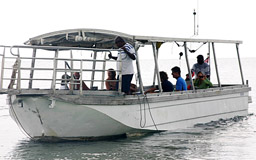 |
|
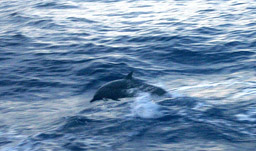 |
|
Numerous times we had dolphins playing alongside the ship |
|
| |
|
|
|
|
|
|
|
|
| |
I was able to join up with the MV Reef Endeavour during a Discovery Heritage Cruise.
Most of the crew are Fijians who, like all the native populace I encountered on my trip, impressed me with their warmth, humor, hospitality, and eagerness to provide insight to their culture and customs. The 65 staterooms are comfortably-sized, with enough drawer and closet space to actually unpack. Rooms have private baths, A/C, and two sizable windows as well as room to move around.
Among the shipboard amenities, you will find a pool, hot tub on the sun deck, a spa, complimentary laundry facilities, and a launching platform that effortlessly hoists the glass-bottomed and diving boats from water-level to deck–level. Meals are served buffet-style in a dining room with huge windows so you don’t miss a single view. One day we were told to come up top, to the Sun Deck, where a wonderful BBQ lunch had been laid out. |
|
| |
|
|
| |
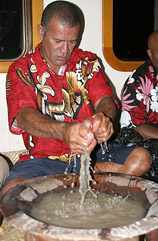 |
|
|
|
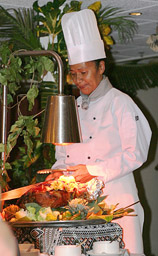 |
|
| |
Preparation of kava involves mixing dried yagona with water in a tanoa bowl until just the right color, indicator of its strength, is obtained |
|
The crew presents a variety of entertainment on Pacific Island Night
|
|
Chef Wati and her staff prepare delicious meals
|
|
| |
|
|
| |
Each evening after dinner, many of the passengers and staff members adjourn to the lounge where some of the crew play piano or guitar and sing. Some guests dance. Some sit at small tables enjoying an after-dinner cocktail. A few folks join a dozen or so crew members who roll out a large woven mat next to the musicians, bring out the hand-carved wooden tanoa bowl and yagona, and settle back for an informal, low-key kava party. If you’ve never had kava, it is mildly narcotic and if strong enough, will make your tongue tingle. It is used as a sort of social gathering among many Polynesian cultures, particularly the Fijians. It’s non-addictive and helps you relax and sleep, so as the evening wears on, the “party” gets more laid back. It’s very advantageous to a good night’s sleep: body relaxed, spirit rejuvenated by the fellowship, slumbering on the gentle rise and fall of the ocean currents that curl about the Fijian islands.
All the adventures and encounters in this story were part of the Captain Cook Cruises Discovery Heritage Cruise. In addition to your room, all meals and diving/snorkeling and guided tours are included. It’s a great way to explore many parts of Fiji as well as access excellent dive and snorkel locations. |
|
| |
|
|
|
|
| |
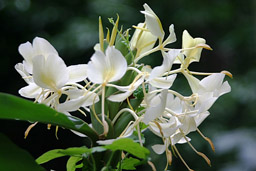 |
|
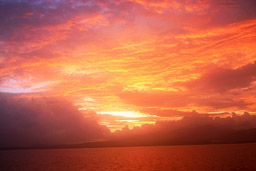 |
|
| |
Fiji flowers |
|
Fiji sunrise |
|
| |
|
|
| |
Perhaps it comes from living with the diverse variety of tropical blooms, stunning sunrises over the Pacific Ocean, or balmy azure waters brimming with marine life. Maybe it’s the rich volcanic soil and plentiful rainfall that nourishes an abundance of foliage and crops. Maybe it’s something in their Polynesian/Melanesian heritage. Whatever the confluence of factors, in Fiji I found some of the most gracious, genuine and giving people I have ever encountered, and they are blessed with one of the most beautiful pieces of real estate on this planet.
Join me next HOA issue when I head back to Viti Levu and visit a famous pottery village, a real “Robinson Crusoe” island, and the great expedition up torrent-washed roads to bob down a river on bamboo rafts so we could hike to a cave where we would slosh through the river’s headwaters and brave the “Pregnancy Gap” on our way to a real-life cannibal oven… but not to worry, it hasn’t been used for nearly 120 years.
Getting to Fiji is fairly effortless for North American travelers. Hop aboard one of Air Pacific’s four weekly non-stops out of Los Angeles International and the next morning you’ll be setting down in Nadi, Fiji. You’ll be served dinner and breakfast, and enjoy your own in-flight entertainment system via seat-back screens. Keep in mind that due to crossing the International Date Line you’ll lose a day heading there, but you’ll return home in the afternoon of the same day as your late evening Fiji departure. That’s a fun fact to confuse the folks back home.
Ready to plan your trip or just learn more about Fiji? Pick up a copy of David Stanley’s Moon Fiji Handbook. A travel-handy size (7.5” x 5.75”), there is a wealth of information in its 419 pages. Well organized, there are sections on each of the major islands and island groups, background about Fiji’s history and culture, useful maps, and sample itineraries such as “The Real Fiji”, “Fiji’s Finest Beaches” and “Diving & Snorkeling Fiji”. The information is up to date, with the Ninth Edition having just rolled off the press in February 2011. In addition to authoring numerous guide books, David Stanley has traveled to 212 of the world’s 245 countries and territories. He knows—and shares—the type of information a visitor wants and needs.
411:
Tourism Fiji www.FijiMe.com; info@tourismfijius.com
Captain Cook Cruises www.captaincook.com.fj; cruise@captaincook.com.fj
Air Pacific www.airpacific.com; reservations@airpacific.com |
|
|
|
|


